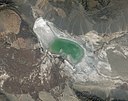File:Shrinking Lake Ebinur 2013.jpg

預覽大小:800 × 533 像素。 其他解析度:320 × 213 像素 | 640 × 427 像素 | 1,024 × 683 像素 | 1,280 × 853 像素 | 2,560 × 1,707 像素 | 5,593 × 3,729 像素。
原始檔案 (5,593 × 3,729 像素,檔案大小:6.86 MB,MIME 類型:image/jpeg)
檔案歷史
點選日期/時間以檢視該時間的檔案版本。
| 日期/時間 | 縮圖 | 尺寸 | 使用者 | 備註 | |
|---|---|---|---|---|---|
| 目前 | 2022年2月12日 (六) 07:46 |  | 5,593 × 3,729(6.86 MB) | Hubert Kororo | Uploaded a work by NASA Earth Observatory image by Robert Simmon and Adam Voiland, using Landsat data from the U.S. Geological Survey. Caption by Adam Voiland. from https://earthobservatory.nasa.gov/images/84785/shrinking-lake-ebinur with UploadWizard |
檔案用途
沒有使用此檔案的頁面。




